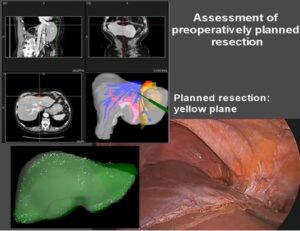Home » Supported Research » Deformation corrected image guided laparoscopic liver surgery
Deformation corrected image guided laparoscopic liver surgery
Title:
Deformation corrected image guided laparoscopic liver surgery
Project Number:
5R01EB027498-02
Contact PI/Project Lead:
Michael Miga
Award Organization:
National Institutes of Health
Abstract:
The scientific premise underpinning this application is that technologies relating the precise physical location of therapy and co-located spatially-encoded disease information, i.e. usually provided by imaging, will enable safer less invasive liver surgical procedures thus increasing surgical candidacy and allowing for more accurate interventions. Going further, this improvement in localization will facilitate the analysis of outcomes for evaluating efficacy, the comparison of approaches, the rating of improvements, and the impact of imaging biomarkers to drive therapy decisions. In this application, while there is potentially broad clinical impact, the specific focus is facilitating and quantifying the spatial accuracy and fidelity of localized image-based information to enhance navigational assistance during laparoscopic liver surgery. Realization would be a fundamental advance in the domain of procedural medicine. The application hypothesis is that biomechanical model-based registration coupled to non-contact digitization can account for soft-tissue deformations and localize intraparenchymal liver targets to an unprecedented error of less than 3 mm of error on average. In addition, we will begin to explore the impact of this technology on locoregional therapies. What also sets this application apart is the strong translational trajectory of the technology through our proposed integration with the on FDA cleared liver guidance system. Another distinction for the application is that we have employed an assessment framework enlisting one of the best hepatopancreatobiliary services in the world at Memorial Sloan Kettering Cancer Center under the supervision of Dr. William R. Jarnagin for the independent evaluation of the technology. This decade+ long collaborative relationship among the co-PIs has been extremely productive (see Multi-PI plan) and is among the most scientifically substantive in the field of image guided liver navigation. The specific aims of the application involve: (1) the integration of deformation correction into a commercial guidance system, (2) the investigation of a novel approach to the laparoscopic indication which includes advances in a non-contact digitization and novel enhancements for modeling insufflation, ligament support, and model heterogeneity, (3) three clinical bystander studies that quantitatively characterize improvements in digitization, and the laparoscopic approach, and (4) an exploratory study that initiates the investigation of the use of the platform for locoregional therapies. In summary, while the focus of the application is a fundamental advance in liver cancer surgical care, it also offers a paradigm shift by providing a novel investigational framework in human systems within the context of procedural medicine.

